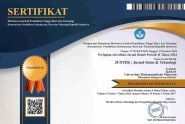Analisis Logam Berat Pada Lahan Bekas Tailing Emas Berdasarkan Sifat Fisik Kimia Tanah
Abstract
Abstrak: Logam berat dianggap sebagai pencemar karena memiliki efek racun pada suatu organisme apabila sudah melebihi konsentrasi tertentu. Tujuan dari penelitian ini adalah untuk mengetahui karakteristik material tanah berdasarkan sifat fisik dan kimia tanah. Metoda yang digunakan untuk mengolah data adalah menggunakan kriteria Penilaian Sifat Kimia Tanah sedangkan kelas tekstur ditentukan berdasarkan motoda Segitiga Tekstur. Hasil dari analisis sifat fisik dan kimia tanah adalah untuk mengetahui tingkat kesuburan tanah tailing. Analisis dilakukan dengan menilai sifat fisika tanah yaitu tekstur tanah, sedangkan penilaian sifat kimia tanah yaitu pH tanah, Kapasitas Tukar Kation (KTK), Kejenuhan Basa (KB), C-Organik, dan persentaase logam Kalium (K), Kalsium (Ca), Magnesium (Mg), Natrium (Na). Hasil penelitian menunjukkan tanah tailing memiliki nilai pH sebesar 8.89 termasuk kategori kalis, hal ini sejalan dengan nilai KTK dan kejenuhan basa tergolong tinggi dan sanggat tinggi dengan nilai 31,33 % dan 94,67 cmol/kg, begitupun dengan nilai Kalium (K), Kalsium (Ca), Magnesium (Mg), Natrium (Na) yang menunjukan jumlah yang sanggat tinggi pada hasil laboratorium pengujian tanah tailing TSF 56. Namun untuk nilai kandungan C-Organik adalah 0.16% termasuk katagori sangat rendah. Untuk nilai permeabilitas tanah tailing cukup rendah yaitu 0.21 %, ini sejalan dengan tesktur tanah tailing yang didominasi oleh liat dan debu sehingga kemampuan melolokan air sangat rendah.
Keywords
Full Text:
PDFReferences
Carlon, C., Critto, A., Marcomini, A. and Nathanail, P. 2001. Risk Based Characterisation of Contaminated Industrial Site Using Multivariate and Geostatistical Tools. Environ. Pollut, 111: 417–427.
Chaoyang. W., Cheng, W. and Linsheng, Y. 2009. Characterizing Spatial Distribution And Sources of Heavy Metals In The Soils From Mining-Smelting Activities In Shuikoushan, Hunan Province, China. Journal of Environmental Sciences, 21: 1230–1236
Dayani, M., and Mohammadi, J. 2010. Geostatistical Assessment of Pb, Zn And Cd Contamination In Near-Surface Soils Of The Urban Mining Transitional Region Of Isfahan, Iran. Pedosphere, 20(5): 568–577.
Ferreira, D.S, E., Zhang, C., Serrano, P.L., Patinha, C. and Reis, P. 2004. Hazard Assessment On Arsenic and Lead in Soils of Castromil Gold Mining Area, Portugal. Appl. Geochem, 19: 887–898.
Gainau, R. J. (2019). Analisis perkembangan tanah pada tailing dam tsf 56 pt. nusa halmahera mineral maluku utara di area suksesi alam (Doctoral dissertation, Universitas Pembangunan Nasional Veteran Yogyakarta)
Gandhimathi, A. and Meenambal, T. 2011. Spatial Prediction Of Heavy Metal Pollution For Soils In Coimbatore, India Based On Universal Kriging (As, Hg, Cd). International Journal of Advanced Engineering Technology, 2: 410– 417.
Gunal, H., Acir, N. and Budak, M. 2012. Heavy Metal Variability of A Native Saline Pasture In Arid Regions Of Central Anatolia. Carpathian Journal Of Earth And Environmental Sciences, 7: 183–193.
Hakim, 1986. Dasar-Dasar Ilmu Tanah. Universitas Lampung, Lampung.
Hanafiah, K. A., 2005. Dasar-Dasar Ilmu Tanah. PT Raja Grafindo Persada, Jakarta.
Liu, Y.G., Zhou, M., Zeng, G.M., Li, X., Xu, W.H. and Fan, T. 2007. Effect of Solids Concentration on Removal of Heavy Metals From Mine Tailings Via Bioleaching. J. Hazard. Mater, 141 (1): 202–208.
Mahmoudabadi, E., Sarmadian, F., Savaghebi, G.H. and Alijani, Z. 2012. Accuracy Assessment of Geostatistical Methods For Zoning Of Heavy Metals In Soils Of Urban-Industrial Areas. International Research Journal Of Applied And Basic Sciences, 3 (5): 991–999.
McGrath, D., Zhang, C. and Carton, O.T. 2004. Geostatistical Analyses And Hazard Assessment On Soil Lead In Silvermines Area, Ireland. Environ. Pollut. 127(2): 239–248.
Mindaugas, R., Gytautas,I., Stanislovas, S., Vytautas, Oškinis. 2012. Assessment of Heavy Metal Contamination and Spatial Distribution in Surface and Subsurface Sediment Layers in The Northern Part of Lake Babrukas. EKOLOGIJA. 2012. Vol. 58. No. 1. P. 33–43.
Muhammad, S., Shah, M. T. and Khan, S. 2011. Heavy metal concentrations in soil and wild plants growing around Pb– Zn sulfide terrain in the Kohistan region, northern Pakistan. Microchemical Journal, 99: 67–75.
Mukhlis, 2007. Analisis Tanah Dan Tanaman. USU press, Medan. 155 Hal
Nasution, 2003. Metode Research (Penelitian Ilmiah). Jakarta : Bumi Aksara.
Navas, A. and Machin, J. 2002. Spatial Distribution of Heavy Metals and Arsenic In Soils of Aragon (Northeast Spain): Controlling Factors and Environmental Implications. Appl. Geochem., 17: 961–973.
Novita S. 2008. Status Kesuburan Tanah di Daerah Reklamasi Tailing dan Pengaruh Keberadaan PT. Freeport Indonesia Terhadap Pengembangan Wilayah di Sekitarnya. Skirpsi Departemen Ilmu Tanah Dan Sumberdaya Lahan. Institut Pertanian Bogor.
Riogilang, H. (2012). Pemanfaatan limbah tambang untuk bahan konstruksi bangunan. Ekoton, 9(1).
Sidabutar. 2013. Perubahan Karakteristik Kimia Tanah Pada Model Reklamasi Lahan Bekas Tambang PT. Antam Ubpe Pongkor. Skripsi Departemen Silvikultr Fakultas Kehutanan. Institut Pertanian Bogor.
Ungaro, F., Ragazzi, F., Cappellin, R. and Giandon, P. (2008). Arsenic Concentration in The Soils of The Brenta Plain (North Italy): Mapping The Probability of Exceeding Contamination Thresholds. J. Geochem. Explor, 96: 117–131.
Refbacks
- There are currently no refbacks.
JUSTEK : Jurnal Sains dan Teknologi sudah terindeks
EDITORIAL OFFICE:












.JPG)

